
Proposals for new Australian States
Encyclopedia
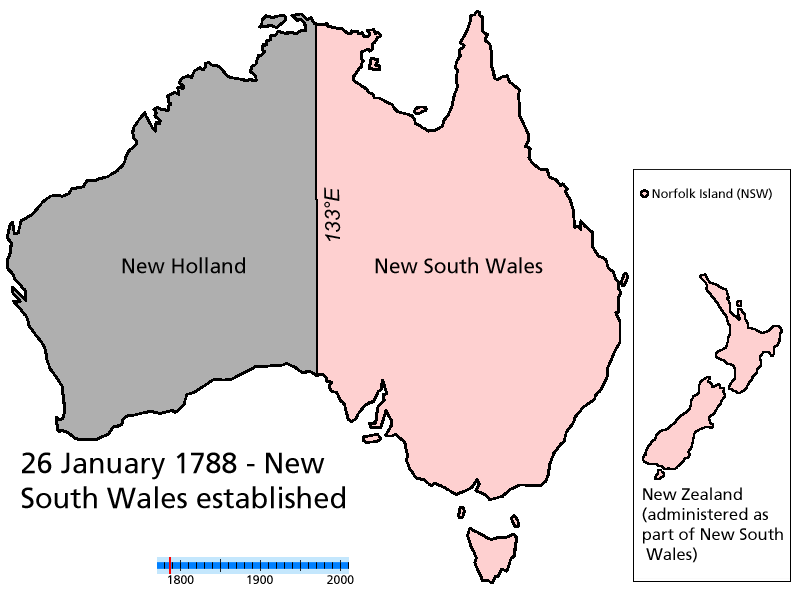
Australia
Australia , officially the Commonwealth of Australia, is a country in the Southern Hemisphere comprising the mainland of the Australian continent, the island of Tasmania, and numerous smaller islands in the Indian and Pacific Oceans. It is the world's sixth-largest country by total area...
have been made in the past century. However, to date, none have been added to the Commonwealth since Federation
Federation of Australia
The Federation of Australia was the process by which the six separate British self-governing colonies of New South Wales, Queensland, South Australia, Tasmania, Victoria and Western Australia formed one nation...
in 1901. Many proposals have suggested an Aboriginal
Australian Aborigines
Australian Aborigines , also called Aboriginal Australians, from the latin ab originem , are people who are indigenous to most of the Australian continentthat is, to mainland Australia and the island of Tasmania...
state which would resemble the Inuit territory
Inuit
The Inuit are a group of culturally similar indigenous peoples inhabiting the Arctic regions of Canada , Denmark , Russia and the United States . Inuit means “the people” in the Inuktitut language...
of Nunavut
Nunavut
Nunavut is the largest and newest federal territory of Canada; it was separated officially from the Northwest Territories on April 1, 1999, via the Nunavut Act and the Nunavut Land Claims Agreement Act, though the actual boundaries had been established in 1993...
in Canada
Canada
Canada is a North American country consisting of ten provinces and three territories. Located in the northern part of the continent, it extends from the Atlantic Ocean in the east to the Pacific Ocean in the west, and northward into the Arctic Ocean...
, whilst others have suggested incorporating New Zealand
New Zealand
New Zealand is an island country in the south-western Pacific Ocean comprising two main landmasses and numerous smaller islands. The country is situated some east of Australia across the Tasman Sea, and roughly south of the Pacific island nations of New Caledonia, Fiji, and Tonga...
, Papua New Guinea
Papua New Guinea
Papua New Guinea , officially the Independent State of Papua New Guinea, is a country in Oceania, occupying the eastern half of the island of New Guinea and numerous offshore islands...
, Fiji
Fiji
Fiji , officially the Republic of Fiji , is an island nation in Melanesia in the South Pacific Ocean about northeast of New Zealand's North Island...
, or New Caledonia
New Caledonia
New Caledonia is a special collectivity of France located in the southwest Pacific Ocean, east of Australia and about from Metropolitan France. The archipelago, part of the Melanesia subregion, includes the main island of Grande Terre, the Loyalty Islands, the Belep archipelago, the Isle of...
as new states.
Formation of new states
Chapter VI of the Constitution of AustraliaConstitution of Australia
The Constitution of Australia is the supreme law under which the Australian Commonwealth Government operates. It consists of several documents. The most important is the Constitution of the Commonwealth of Australia...
allows for the establishment or admission of new states to the Federation. It may also increase, diminish, or otherwise alter the limits of a state, form new states by separating territory from an existing state, or join two states or parts of states, but in each case it must have the approval of the parliaments of the states in question.
New colony proposals
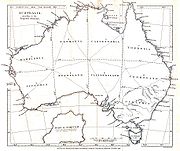
North Australia
North Australia can refer to a former territory, a former colony or a proposed state which would replace the current Northern Territory.-Colony :...
was briefly a colony between February and December 1846. The Journal of the Royal Geographical Society published Considerations on the Political Geography and Geographical Nomenclature of Australia in 1838, in which the following divisions were proposed:
- DampieriaWilliam DampierWilliam Dampier was an English buccaneer, sea captain, author and scientific observer...
in northwestern Australia. - Queen Victoria in southwestern Australia (not to be confused with the modern Victoria).
- TasmaniaAbel TasmanAbel Janszoon Tasman was a Dutch seafarer, explorer, and merchant, best known for his voyages of 1642 and 1644 in the service of the VOC . His was the first known European expedition to reach the islands of Van Diemen's Land and New Zealand and to sight the Fiji islands...
in Western Australia (not to be confused with the modern TasmaniaTasmaniaTasmania is an Australian island and state. It is south of the continent, separated by Bass Strait. The state includes the island of Tasmania—the 26th largest island in the world—and the surrounding islands. The state has a population of 507,626 , of whom almost half reside in the greater Hobart...
). - NuytslandPieter NuytsPieter Nuyts or Nuijts was a Dutch explorer, diplomat, and politician.He was part of a landmark expedition of the Dutch East India Company in 1626–27, which mapped the southern coast of Australia. He became the Dutch ambassador to Japan in 1627, and he was appointed Governor of Formosa in the same...
near the Nullarbor PlainNullarbor PlainThe Nullarbor Plain is part of the area of flat, almost treeless, arid or semi-arid country of southern Australia, located on the Great Australian Bight coast with the Great Victoria Desert to its north. It is the world's largest single piece of limestone, and occupies an area of about...
. - CarpentariaGulf of CarpentariaThe Gulf of Carpentaria is a large, shallow sea enclosed on three sides by northern Australia and bounded on the north by the Arafura Sea...
south of the Gulf of CarpentariaGulf of CarpentariaThe Gulf of Carpentaria is a large, shallow sea enclosed on three sides by northern Australia and bounded on the north by the Arafura Sea...
. - FlinderslandMatthew FlindersCaptain Matthew Flinders RN was one of the most successful navigators and cartographers of his age. In a career that spanned just over twenty years, he sailed with Captain William Bligh, circumnavigated Australia and encouraged the use of that name for the continent, which had previously been...
in south central Australia. - Torresia in northern QueenslandQueenslandQueensland is a state of Australia, occupying the north-eastern section of the mainland continent. It is bordered by the Northern Territory, South Australia and New South Wales to the west, south-west and south respectively. To the east, Queensland is bordered by the Coral Sea and Pacific Ocean...
. - CookslandJames CookCaptain James Cook, FRS, RN was a British explorer, navigator and cartographer who ultimately rose to the rank of captain in the Royal Navy...
centred around BrisbaneBrisbaneBrisbane is the capital and most populous city in the Australian state of Queensland and the third most populous city in Australia. Brisbane's metropolitan area has a population of over 2 million, and the South East Queensland urban conurbation, centred around Brisbane, encompasses a population of...
. - Guelphia in southeastern Australia.
- Van Diemen's LandVan Diemen's LandVan Diemen's Land was the original name used by most Europeans for the island of Tasmania, now part of Australia. The Dutch explorer Abel Tasman was the first European to land on the shores of Tasmania...
in modern day Tasmania.
These proposed states were geometric divisions of the continent, and did not take into account soil fertility, aridity or population. This meant that central and western Australia were divided into several states, despite their low populations both then and now.
There was also a proposal in 1857 for the "Seven United Provinces of Eastern Australia" with separate provinces of Flinders Land, Leichardt's Land (taken from the name of Ludwig Leichhardt
Ludwig Leichhardt
Friedrich Wilhelm Ludwig Leichhardt, known as Ludwig Leichhardt, was a Prussian explorer and naturalist, most famous for his exploration of northern and central Australia.-Early life:...
) and Cook's Land in modern day Queensland (also named from James Cook
James Cook
Captain James Cook, FRS, RN was a British explorer, navigator and cartographer who ultimately rose to the rank of captain in the Royal Navy...
).
Australian Capital Territory

Australian Capital Territory
The Australian Capital Territory, often abbreviated ACT, is the capital territory of the Commonwealth of Australia and is the smallest self-governing internal territory...
has a small number of vocal statehood supporters, who believe the ACT, with a population only slightly less than that of Tasmania, is under-represented in the Australian Parliament
Parliament of Australia
The Parliament of Australia, also known as the Commonwealth Parliament or Federal Parliament, is the legislative branch of the government of Australia. It is bicameral, largely modelled in the Westminster tradition, but with some influences from the United States Congress...
. This movement may be likened to supporters of statehood
District of Columbia statehood movement
The District of Columbia statehood movement is a political movement that advocates making the District of Columbia a U.S. state. Statehood would give the citizens of Washington, D.C. full representation in the United States Congress and full control over their own local affairs.Full statehood for D.C...
for the District of Columbia
Washington, D.C.
Washington, D.C., formally the District of Columbia and commonly referred to as Washington, "the District", or simply D.C., is the capital of the United States. On July 16, 1790, the United States Congress approved the creation of a permanent national capital as permitted by the U.S. Constitution....
in the United States
United States
The United States of America is a federal constitutional republic comprising fifty states and a federal district...
, though it is much smaller and no prominent political figures have given it their support. Furthermore, the wording of s.125 of the Australian Constitution suggests that the ACT must remain a territory and cannot become a state.

Northern Territory
The Northern TerritoryNorthern Territory
The Northern Territory is a federal territory of Australia, occupying much of the centre of the mainland continent, as well as the central northern regions...
is the most commonly mentioned potential seventh state. In a 1998 referendum
Northern Territory referendum, 1998
A referendum was held in the Northern Territory on Saturday, 3 October 1998, to decide whether the Territory should become a State of the Commonwealth of Australia. The Country Liberal Party government, and its federal counterpart, supported the Yes case. The opposition Australian Labor Party...
, the voters of the NT rejected a statehood proposal that would have given the Territory three Senators
Australian Senate
The Senate is the upper house of the bicameral Parliament of Australia, the lower house being the House of Representatives. Senators are popularly elected under a system of proportional representation. Senators are elected for a term that is usually six years; after a double dissolution, however,...
, rather than the 12 Senators held by the other states, although the name "Northern Territory" would have been retained. This ABC Lateline interview gives much insight into both sides of the debate in 1998. With statehood rejected, it is likely that the Northern Territory will remain a territory for the near future, though former Chief Minister
Chief Minister of the Northern Territory
The Chief Minister of the Northern Territory is appointed by the Administrator, who in normal circumstances will appoint the head of whatever party holds the majority of seats in the legislature of the territory...
Clare Martin
Clare Martin
Clare Majella Martin is a former Australian politician. She is the current CEO of the Australian Council of Social Service . A former journalist, she was elected to the Northern Territory Legislative Assembly in a shock by-election win in 1995...
and the majority of Territorians are said to be in favour of statehood. The main argument against statehood has been the NT's relatively low population.
An alternative name for the new state would be North Australia
North Australia
North Australia can refer to a former territory, a former colony or a proposed state which would replace the current Northern Territory.-Colony :...
, which would be shared by two historic regions.
North Queensland
The people of northern North QueenslandNorth Queensland
North Queensland or the Northern Region is the northern part of the state of Queensland in Australia. Queensland is a massive state, larger than most countries, and the tropical northern part of it has been historically remote and undeveloped, resulting in a distinctive regional character and...
, sometimes called "Far North Queensland
Far North Queensland
Far North Queensland, or FNQ, is the northernmost part of the Australian state of Queensland. The region, which contains a large section of the Tropical North Queensland area, stretches from the city of Cairns north to the Torres Strait...
" or "Capricornia
Capricornia
Capricornia is a term sometimes used for northern Australia, derived from the Tropic of Capricorn. It can apply to any of the items below:* Areas associated with Queensland:...
", have long held views and self-identification distinct from that of the southern parts of the state. Proposals for the political separation of North Queensland, comprising mainly the Cape York Peninsula
Cape York Peninsula
Cape York Peninsula is a large remote peninsula located in Far North Queensland at the tip of the state of Queensland, Australia, the largest unspoilt wilderness in northern Australia and one of the last remaining wilderness areas on Earth...
, have been forwarded from time to time, with mixed results. Arguably, efforts for statehood in North Queensland would be hampered by the region's small population, although if Central Queensland was included, the state could potentially have a population higher than South Australia
South Australia
South Australia is a state of Australia in the southern central part of the country. It covers some of the most arid parts of the continent; with a total land area of , it is the fourth largest of Australia's six states and two territories.South Australia shares borders with all of the mainland...
.
Riverina
RiverinaRiverina
The Riverina is an agricultural region of south-western New South Wales , Australia. The Riverina is distinguished from other Australian regions by the combination of flat plains, warm to hot climate and an ample supply of water for irrigation. This combination has allowed the Riverina to develop...
is also a proposed state, in the River Murray region, on the border between New South Wales and Victoria. The Division of Riverina
Division of Riverina
The Division of Riverina is an Australian Electoral Division in the state of New South Wales. It is located in south-west rural New South Wales, generally following the Murrumbidgee River valley. It includes the cities of Wagga Wagga and Griffith as well as the towns of Junee, West Wyalong, Tumut,...
is currently a smaller area than traditional Riverina, which would include the Division of Farrer
Division of Farrer
The Division of Farrer is an Australian Electoral Division in New South Wales. The division was created in 1949 and is named for William Farrer, agricultural scientist. It is located in the southern rural area of the state and includes Albury, Balranald, Deniliquin and Jerilderie. It has always...
. Along with the ACT, it is one of the few landlocked proposed states.
Aboriginal state
There are also supporters of an Aboriginal state, along the lines of the recently created NunavutNunavut
Nunavut is the largest and newest federal territory of Canada; it was separated officially from the Northwest Territories on April 1, 1999, via the Nunavut Act and the Nunavut Land Claims Agreement Act, though the actual boundaries had been established in 1993...
in Canada. Agence France Presse (21/8/98) claims Australia blocked a United Nations resolution calling for the self-determination of peoples
Declaration on the Rights of Indigenous Peoples
The United Nations Declaration on the Rights of Indigenous Peoples was adopted by the United Nations General Assembly during its 62nd session at UN Headquarters in New York City on 13 September 2007....
, because it would have bolstered support for an Aboriginal state within Australia. Amongst those supporting such a state are the Council for Aboriginal Reconciliation.
Auralia
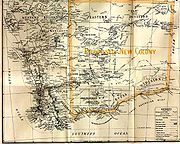
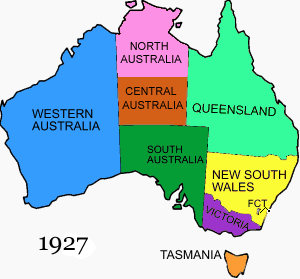
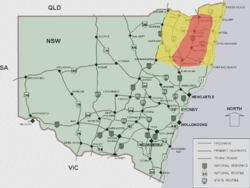
Auralia
Auralia was a proposed state that would have been formed out of the south-eastern portion of the colony of Western Australia in the early twentieth century , and would have joined the newly formed Commonwealth of Australia...
(meaning "land of gold") would have comprised the Goldfields, the western portion of the Nullarbor Plain
Nullarbor Plain
The Nullarbor Plain is part of the area of flat, almost treeless, arid or semi-arid country of southern Australia, located on the Great Australian Bight coast with the Great Victoria Desert to its north. It is the world's largest single piece of limestone, and occupies an area of about...
and the port town of Esperance
Esperance, Western Australia
Esperance is a large town in the Goldfields-Esperance region of Western Australia, located on the Southern Ocean coastline approximately east-southeast of the state capital, Perth. The shire of Esperance is home to 9,536 people as of the 2006 census, its major industries are tourism, agriculture,...
. Its capital would have been Kalgoorlie. However, the population in Goldfields-Esperance is currently lower than that of the Northern Territory
Northern Territory
The Northern Territory is a federal territory of Australia, occupying much of the centre of the mainland continent, as well as the central northern regions...
, and there is not much evidence of support, although the idea of a state around Kalgoorlie has been revived.
Central Australia
In 1927 the Northern Territory administrated devolved authority for the governing of the southern portion of the territory known as Central AustraliaCentral Australia
Central Australia/Alice Springs Region is one of the five regions in the Northern Territory. The term Central Australia is used to describe an area centred on Alice Springs in Australia. It is sometimes referred to as Centralia; likewise the people of the area are sometimes called Centralians...
, with power vested in an administrator resident in Alice Springs. The arrangement was discontinued in 1931.
Illawarra Province
Also known as the IllawarraIllawarra
Illawarra is a region in the Australian state of New South Wales. It is a coastal region situated immediately south of Sydney and north of the Shoalhaven or South Coast region. It encompasses the cities of Wollongong, Shellharbour, Shoalhaven and the town of Kiama. The central region contains Lake...
Territory, this proposed new state would consist of the Illawarra region centred around Wollongong on the New South Wales south coast. Originally this idea arose after disagreements between local landowners and migrants from Sydney in the mid-19th century. However the idea has continued in various incarnations ever since with most movements proposing the state's capital be situated in "Illawarra City", or the amalgamation of the Shellharbour and Kiama local government areas.
New England
The New EnglandNew England (Australia)
New England or New England North West is the name given to a generally undefined region about 60 kilometres inland, that includes the Northern Tablelands and the North West Slopes regions in the north of the state of New South Wales, Australia.-History:The region has been occupied by Indigenous...
region of New South Wales
New South Wales
New South Wales is a state of :Australia, located in the east of the country. It is bordered by Queensland, Victoria and South Australia to the north, south and west respectively. To the east, the state is bordered by the Tasman Sea, which forms part of the Pacific Ocean. New South Wales...
has had a devoted statehood movement since the 1930s. In the 1960s this movement was particularly active. The movement has historically gained strength when a Labor
Australian Labor Party
The Australian Labor Party is an Australian political party. It has been the governing party of the Commonwealth of Australia since the 2007 federal election. Julia Gillard is the party's federal parliamentary leader and Prime Minister of Australia...
government, generally dominated by urban interests, is in power in Sydney
Sydney
Sydney is the most populous city in Australia and the state capital of New South Wales. Sydney is located on Australia's south-east coast of the Tasman Sea. As of June 2010, the greater metropolitan area had an approximate population of 4.6 million people...
.
Some supporters also propose a "River-Eden" state in the south of NSW.
North Coast
This proposed state takes in the northern part of New South Wales from TareeTaree, New South Wales
Taree is a city on the Mid North Coast, New South Wales, Australia. Taree and nearby Cundletown were settled in 1831 by William Wynter. Since then Taree has grown to a population of around 20,000 people and is the centre of a significant agricultural district. It is 16 km from the sea coast,...
to the Queensland Border, mainly in the north east, and excluding most of north west NSW.
South Coast
There was a small movement in the 1940s to create a new state in south-east New South Wales and north-east Victoria. The proposed state would have reached from Batemans BayBatemans Bay, New South Wales
- Media :Radio Stations*East Coast Radio 2EC *Power FM NSW South Coast - POWER FM from Nowra can also be received in parts of Batemans Bay on FM 94.9....
on the coast to Kiandra
Kiandra, New South Wales
Kiandra is an abandoned gold mining town and the birthplace of Australian skiing. The town is situated in the Snowy Mountains of New South Wales, Australia, in the Snowy River Shire inside the Kosciuszko National Park. Its name is a corruption of Aboriginal 'Gianderra' for 'sharp stones for...
in the Snowy Mountains
Snowy Mountains
The Snowy Mountains, known informally as "The Snowies", are the highest Australian mountain range and contain the Australian mainland's highest mountain, Mount Kosciuszko, which reaches 2,228 metres AHD, approximately 7310 feet....
, and as far south as Sale
Sale, Victoria
Sale is a city in the Gippsland region of the Australian state of Victoria. It is the seat of the Shire of Wellington as well as the Roman Catholic Diocese of Sale and the Anglican Diocese of Gippsland. It has a population of around 13,336, and is expected to reach a population of 14,000 soon...
in Victoria
Victoria (Australia)
Victoria is the second most populous state in Australia. Geographically the smallest mainland state, Victoria is bordered by New South Wales, South Australia, and Tasmania on Boundary Islet to the north, west and south respectively....
. The proposed state capital was Bega
Bega, New South Wales
Bega is a town in the south-east of New South Wales, Australia in the Bega Valley Shire. It is the economic centre for the Bega Valley.-Place name:One claim is that place name Bega is derived from the local Aboriginal word meaning "big camping ground"....
. Despite calls from local advocacy groups for a Royal Commission into the idea, it was met with little success.
Princeland
This proposed colony resulted from a movement in the 1860s to create a new colony that incorporated the isolated western Victoria and south-eastern South Australia regions centred around Mount GambierMount Gambier, South Australia
Mount Gambier is the largest regional city in South Australia located approximately 450 kilometres south of the capital Adelaide and just 17 kilometres from the Victorian border....
and Portland
Portland, Victoria
The city of Portland is the oldest European settlement in what is now the state of Victoria, Australia. It is the main urban centre of the Shire of Glenelg. It is located on Portland Bay.-History:...
. A petition was presented to Queen Victoria, but was rejected.
New Zealand

North Island
The North Island is one of the two main islands of New Zealand, separated from the much less populous South Island by Cook Strait. The island is in area, making it the world's 14th-largest island...
and South Island
South Island
The South Island is the larger of the two major islands of New Zealand, the other being the more populous North Island. It is bordered to the north by Cook Strait, to the west by the Tasman Sea, to the south and east by the Pacific Ocean...
could become separate states in the Commonwealth, which would provide New Zealand interests with a greater say. New Zealand was one of the colonies asked to join in the creation of the Commonwealth of Australia. As ties have grown closer
Australia-New Zealand relations
Relations between Australia and New Zealand, also sometimes referred to as Trans-Tasman relations due to the countries being on opposite sides of the Tasman Sea, are extremely close with both sharing British colonial heritage and being part of the Anglosphere...
, people have made proposals for a customs union
Customs union
A customs union is a type of trade bloc which is composed of a free trade area with a common external tariff. The participant countries set up common external trade policy, but in some cases they use different import quotas...
, currency union
Currency union
A currency union is where two or more states share the same currency, though without there necessarily having any further integration such as an Economic and Monetary Union, which has in addition a customs union and a single market.There are three types of currency unions:#Informal - unilateral...
and even a joint defence force
Military
A military is an organization authorized by its greater society to use lethal force, usually including use of weapons, in defending its country by combating actual or perceived threats. The military may have additional functions of use to its greater society, such as advancing a political agenda e.g...
. New Zealand and Australia enjoy close economic and political relations, mainly by way of the Trans-Tasman Travel Arrangement
Trans-Tasman Travel Arrangement
The Trans-Tasman Travel Arrangement is an informal agreement between Australia and New Zealand to allow for the free movement of citizens of one nation to the other.- Treaty history :...
, Closer Economic Relations
Closer Economic Relations
Closer Economic Relations is a free trade agreement between the governments of New Zealand and Australia. It is also known as the Australia New Zealand Closer Economic Relations Trade Agreement and sometimes shortened to...
(CER) free trade agreement signed in 1983 and the Closer Defence Relations agreement signed in 1990. In 1989, former Prime Minister of New Zealand
Prime Minister of New Zealand
The Prime Minister of New Zealand is New Zealand's head of government consequent on being the leader of the party or coalition with majority support in the Parliament of New Zealand...
Sir Geoffrey Palmer said that New Zealand had "...gained most of the advantages of being a state of Australia without becoming one". The two countries, along with the USA, are in ANZUS
ANZUS
The Australia, New Zealand, United States Security Treaty is the military alliance which binds Australia and New Zealand and, separately, Australia and the United States to cooperate on defence matters in the Pacific Ocean area, though today the treaty is understood to relate to attacks...
, but New Zealand's opposition to nuclear weapon
Nuclear weapon
A nuclear weapon is an explosive device that derives its destructive force from nuclear reactions, either fission or a combination of fission and fusion. Both reactions release vast quantities of energy from relatively small amounts of matter. The first fission bomb test released the same amount...
s has weakened this treaty.
History
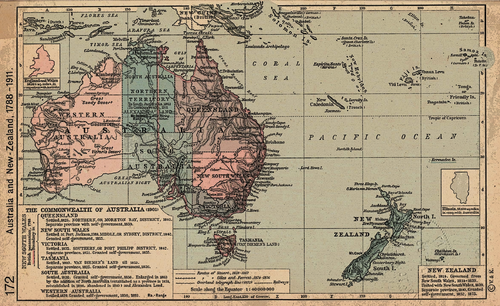
Arthur Phillip
Admiral Arthur Phillip RN was a British admiral and colonial administrator. Phillip was appointed Governor of New South Wales, the first European colony on the Australian continent, and was the founder of the settlement which is now the city of Sydney.-Early life and naval career:Arthur Phillip...
assumed the position of Governor of New South Wales, claiming New Zealand as part of New South Wales
New South Wales
New South Wales is a state of :Australia, located in the east of the country. It is bordered by Queensland, Victoria and South Australia to the north, south and west respectively. To the east, the state is bordered by the Tasman Sea, which forms part of the Pacific Ocean. New South Wales...
. In 1835 a group of Māori chiefs signed the Declaration of Independence
Declaration of the Independence of New Zealand
In New Zealand political and social history, the Declaration of the Independence of New Zealand , was signed by a number of Māori chiefs in 1835, proclaimed the sovereign independence of New Zealand prior to the signing of the Treaty of Waitangi in 1840....
, which established New Zealand as a sovereign nation. A few years later the Treaty of Waitangi
Treaty of Waitangi
The Treaty of Waitangi is a treaty first signed on 6 February 1840 by representatives of the British Crown and various Māori chiefs from the North Island of New Zealand....
re-established British control of New Zealand. The Federal Council of Australasia
Federal Council of Australasia
The Federal Council of Australasia was a forerunner to the current Commonwealth of Australia, though its structure and members were different. It consisted of the then British colonies of New Zealand, Victoria, Tasmania, South Australia, Fiji, and others. However, the largest colony in the region,...
was formed with members representing New Zealand, Victoria, Tasmania, South Australia and Fiji. Although it held no official power it was a step into the establishment of the Commonwealth of Australia. In 1890 there was an informal meeting of members from the Australasian colonies, this was followed by the first National Australasian convention a year later. The New Zealand representatives stated it would be unlikely to join a federation with Australia at its foundation but it would be interested in doing so at a later date. New Zealand's position was taken into account when the Constitution of Australia was written up. The only reason New Zealand did not join was fears of racist laws towards the Māori because of Australia's treatment of the Australian Aboriginals. Australia in an attempt to sway New Zealand to join gave Māori the right to vote in 1902, while Australian Aboriginals did not gain the right to vote until 1962. New Zealand and Australian soldiers fought together in 1915 under the name ANZAC
Australian and New Zealand Army Corps
The Australian and New Zealand Army Corps was a First World War army corps of the Mediterranean Expeditionary Force that was formed in Egypt in 1915 and operated during the Battle of Gallipoli. General William Birdwood commanded the corps, which comprised troops from the First Australian Imperial...
.
Australian academic Bob Catley wrote a book titled Waltzing with Matilda: should New Zealand join Australia?, a book arguing why New Zealand should become one with Australia. In December 2006, an Australian Federal Parliamentary Committee recommended that Australia and New Zealand pursue a full union, or at least adopt a common ANZ currency and more common markets. The Committee found that "while Australia and New Zealand are of course two sovereign nations, it seems ... that the strong ties between the two countries - the economic, cultural, migration, defence, governmental and people-to-people linkages - suggest that an even closer relationship, including the possibility of union, is both desirable and realistic." This was despite the Australian Treasurer
Treasurer of Australia
The Treasurer of Australia is the minister in the Government of Australia responsible for government expenditure and revenue raising. He is the head of the Department of the Treasury. The Treasurer plays a key role in the economic policy of the government...
Peter Costello
Peter Costello
Peter Howard Costello AC is an Australian politician and lawyer who served as the Treasurer in the Australian government from 1996 to 2007. He is the longest-serving Treasurer in Australian history. Costello was a Member of the Australian House of Representatives from 1990 to 2009, representing...
and New Zealand Minister of Finance
Minister of Finance (New Zealand)
The Minister of Finance is a senior figure within the government of New Zealand. The position is often considered to be the most important Cabinet role after that of the Prime Minister....
Michael Cullen saying that a common currency was "not on the agenda." A recent UMR research poll asked 1000 people in Australia and New Zealand a series of questions relating to New Zealand becoming the seventh state of Australia. One quarter of the people thought it was something to look into. Over 40% thought the idea was worth debating. More Australians than New Zealanders would support such a move.
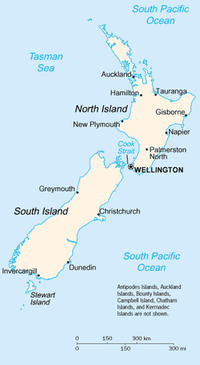
Reasons for
There are many reasons why people have called for New Zealand to become the seventh state of Australia. Some of the reasons depend which side of the Tasman the person is on. A prominent reason appears to be the two countries are very alike, from their similar flags to their culture values. According to the UMR poll results most people believe the New Zealand economy and the ease of travel between countries would be better if New Zealand joined Australia. A leading factor for the proposal of New Zealand as a state of Australia is the major economic benefits it would bring. But at present, free tradeFree trade
Under a free trade policy, prices emerge from supply and demand, and are the sole determinant of resource allocation. 'Free' trade differs from other forms of trade policy where the allocation of goods and services among trading countries are determined by price strategies that may differ from...
and open borders appear to be the maximum extent of public acceptance of the proposal. New Zealand's health system would improve. There are a lot of family connections between the two nations, with nearly half a million New Zealanders currently living in Australia. Peter Slipper
Peter Slipper
Peter Neil Slipper , Australian politician, has served as the 27th Speaker of the Australian House of Representatives since November 2011, after serving as Deputy Speaker following the 2010 election...
, a Member of Australia's Parliament, once said "It's about how can we improve the quality of living for people on both sides of the Tasman." when referring to the proposal.
Reasons against
The modern reasons for New Zealand not becoming the seventh state differ from the original belief that Māori may be mistreated under Australian law. The main reason for New Zealanders refusing the proposal is not wanting to be labelled an 'Australian'. Each country has its own currency which would mean a common currency would have to be created before New Zealand becomes a state. Also there have been fears of New Zealand losing its nuclear-free status, although these fears are unfounded, Australia was even one of the nations to sign the South Pacific Nuclear Free Zone Treaty. New Zealand has stronger administrative and political recognition of the ancestral rights of its indigenous Maori population due to the Treaty of WaitangiTreaty of Waitangi
The Treaty of Waitangi is a treaty first signed on 6 February 1840 by representatives of the British Crown and various Māori chiefs from the North Island of New Zealand....
, whereas Australia does not. However, the Treaty of Waitangi would continue in operation in any union, just as it has through New Zealand's development from colony to independent nation. New Zealand also has a Bill of Rights
Bill of rights
A bill of rights is a list of the most important rights of the citizens of a country. The purpose of these bills is to protect those rights against infringement. The term "bill of rights" originates from England, where it referred to the Bill of Rights 1689. Bills of rights may be entrenched or...
, albeit not entrenched, whereas Australia does not, at least as a federal level. There are also disparities that would lead to conflict within social movements on either side of the Tasman. Same-sex marriage in New Zealand
Same-sex marriage in New Zealand
New Zealand does not currently allow same-sex marriages, but allows civil unions that provide virtually all the rights and responsibilities of marriage...
is not subject to a prescriptive federal statutory ban, unlike same-sex marriage in Australia
Same-sex marriage in Australia
Same-sex marriages are currently not permitted under Australian federal law. In 2004 the Marriage Act 1961 was amended in federal parliament to expressly state that marriage is considered a union between a man and a woman only and that any existing same-sex marriage from a foreign country is not to...
, as one example. Some New Zealanders feel they have established a national identity, one which they feel they may lose if they became part of Australia. Others argue New Zealand is too far away from the mainland of Australia, although Julius Vogel once stated, Otago was three times as far from the Auckland than it was from Victoria or Tasmania in terms of shipping days.
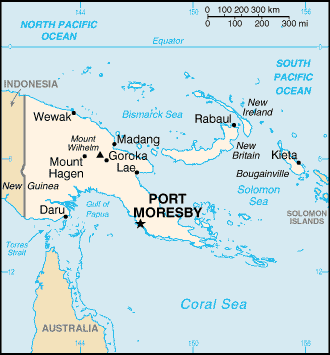
Papua New Guinea
Papua New GuineaPapua New Guinea
Papua New Guinea , officially the Independent State of Papua New Guinea, is a country in Oceania, occupying the eastern half of the island of New Guinea and numerous offshore islands...
is the physically closest of any country to geographically remote Australia, with some of the Torres Strait Islands
Torres Strait Islands
The Torres Strait Islands are a group of at least 274 small islands which lie in Torres Strait, the waterway separating far northern continental Australia's Cape York Peninsula and the island of New Guinea but Torres Strait Island known and Recognize as Nyumaria.The islands are mostly part of...
just off the main island of the country. In 1953, the editor of the conservative Quadrant
Quadrant (magazine)
Quadrant is an Australian literary and cultural journal. The magazine takes a conservative position on political and social issues, describing itself as sceptical of 'unthinking Leftism, or political correctness, and its "smelly little orthodoxies"'. Quadrant reviews literature, as well as...
magazine, Professor James McAuley
James McAuley
James Phillip McAuley was an Australian academic, poet, journalist, literary critic and a prominent convert to Roman Catholicism.-Life and career:...
, wrote that the territory would be "a coconut republic which would do little good for itself", and advocated its "perpetual union" with Australia, with equal citizenship rights.", but this was rejected by the Australian government which instead granted the territory self-government, and full independence in 1975.
East Timor
During the process of PortuguesePortugal
Portugal , officially the Portuguese Republic is a country situated in southwestern Europe on the Iberian Peninsula. Portugal is the westernmost country of Europe, and is bordered by the Atlantic Ocean to the West and South and by Spain to the North and East. The Atlantic archipelagos of the...
decolonisation in East Timor
East Timor
The Democratic Republic of Timor-Leste, commonly known as East Timor , is a state in Southeast Asia. It comprises the eastern half of the island of Timor, the nearby islands of Atauro and Jaco, and Oecusse, an exclave on the northwestern side of the island, within Indonesian West Timor...
in 1974, a political party was formed called ADITLA Associação Democrática para a Integração de Timor Leste na Austrália or Democratic Association for the Integration of East Timor into Australia, by local businessman Henrique Pereira. It found some support from the ethnic Chinese
Overseas Chinese
Overseas Chinese are people of Chinese birth or descent who live outside the Greater China Area . People of partial Chinese ancestry living outside the Greater China Area may also consider themselves Overseas Chinese....
community, fearful of independence or integration with Indonesia
Indonesia
Indonesia , officially the Republic of Indonesia , is a country in Southeast Asia and Oceania. Indonesia is an archipelago comprising approximately 13,000 islands. It has 33 provinces with over 238 million people, and is the world's fourth most populous country. Indonesia is a republic, with an...
, but was disbanded when the Australian government rejected the idea in 1975.
Proponents of new states
Some members of the National PartyNational Party of Australia
The National Party of Australia is an Australian political party.Traditionally representing graziers, farmers and rural voters generally, it began as the The Country Party, but adopted the name The National Country Party in 1975, changed to The National Party of Australia in 1982. The party is...
(former Country Party) have been especially supportive of new states, since they believe it would decentralise Australia and benefit rural areas more.
In addition to the above, Bryan Pape
Bryan Pape
Bryan Pape was a senior lecturer at the University of New England, New South Wales, Australia and a former office holder and member of the National Party of Australia,...
, National Party
National Party of Australia
The National Party of Australia is an Australian political party.Traditionally representing graziers, farmers and rural voters generally, it began as the The Country Party, but adopted the name The National Country Party in 1975, changed to The National Party of Australia in 1982. The party is...
official and senior lecturer in law at the University of New England
University of New England, Australia
The University of New England is an Australian public university with approximately 18,000 higher education students. Its original and main campus is located in the city of Armidale in northern New South Wales....
, has suggested further subdivision of Victoria and the following states, resulting in possibly as many as twenty Australian states: A suggested reorganisation of Australia's states could include:
- Central Australia
- Northern Australia
- ArnhemArnhem LandThe Arnhem Land Region is one of the five regions of the Northern Territory of Australia. It is located in the north-eastern corner of the territory and is around 500 km from the territory capital Darwin. The region has an area of 97,000 km² which also covers the area of Kakadu National...
/KakaduKakadu National ParkKakadu National Park is in the Northern Territory of Australia, 171 km southeast of Darwin.Kakadu National Park is located within the Alligator Rivers Region of the Northern Territory of Australia. It covers an area of , extending nearly 200 kilometres from north to south and over 100 kilometres...
- Arnhem
- Queensland
- Carpenteria
- Cape York/North Queensland
- South Australia
- Whyalla
- Eyre PeninsulaEyre PeninsulaEyre Peninsula is a triangular peninsula in South Australia. It is bounded on the east by Spencer Gulf, the west by the Great Australian Bight, and the north by the Gawler Ranges. It is named after explorer Edward John Eyre who explored some of it in 1839-1841. The coastline was first explored by...
- Victoria
- GippslandGippslandGippsland is a large rural region in Victoria, Australia. It begins immediately east of the suburbs of Melbourne and stretches to the New South Wales border, lying between the Great Dividing Range to the north and Bass Strait to the south...
- BallaratBallarat, VictoriaBallarat is a city in the state of Victoria, Australia, approximately west-north-west of the state capital Melbourne situated on the lower plains of the Great Dividing Range and the Yarrowee River catchment. It is the largest inland centre and third most populous city in the state and the fifth...
-Bendigo/Goldfields - WimmeraWimmeraThe Wimmera is a region in the west of the Australian state of Victoria.It covers the dryland farming area south of the range of Mallee scrub, east of the South Australia border and north of the Great Dividing Range...
-The MalleeThe MalleeThe Mallee is the most northwesterly district in the state of Victoria, and also encompasses the agricultural district of South Australia. Definitions vary, however all are based on the Victorian distribution of mallee eucalypts...
- Gippsland
- Western Australia
- Kimberley
- Pilbara
- Kalgoorlie/Goldfields
See also
- Australian regional rivalriesAustralian regional rivalriesAustralian regional rivalries refers to the rivalries between Australian cities or regions.-Sydney - Melbourne rivalry:There has been a long standing rivalry between the cities of Sydney and Melbourne, the two largest cities in Australia...
- Proposed provinces and territories of Canada
- Secessionism in Western AustraliaSecessionism in Western AustraliaSecessionism has been a recurring feature of Western Australia's political landscape since shortly after European settlement in 1829. The idea of self governance or secession has often been discussed through local newspaper articles and editorials and on a number of occasions has surfaced as very...
- 51st state51st stateThe 51st state, in United States political discourse, is a phrase that refers to areas either seriously or derisively considered candidates for addition to the 50 states already part of the United States. Before 1959, when Alaska and Hawaii joined the U.S., the term "the 49th state" was used...
- List of regions in Australia
- Australia – New Zealand relations
- Australia – Papua New Guinea relations
External links
- 'Altered States', Sydney Morning Herald 25 January 2005
- New States for Australia
- New states Introduction - Ian Johnston's new Australian States webpage
- The man who's creating a United States of Australia
- Proposed North Queensland flag and brief history
- North Queensland secession discussion forum
- Why New Zealand did not become an Australian State

